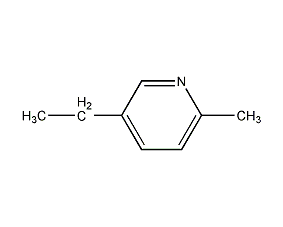
Structural formula
| Business number | 02QX |
|---|---|
| Molecular formula | C8H11N |
| Molecular weight | 121.18 |
| label |
5-ethyl-2-picoline, 5-Ethyl-2-picoline |
Numbering system
CAS number:104-90-5
MDL number:MFCD00006344
EINECS number:203-250-0
RTECS number:TJ6825000
BRN number:109269
PubChem number:24901774
Physical property data
1. Properties: colorless liquid
2. Density (g/mL, 25℃): 0.9184
3. Relative vapor density (g/mL, air=1 ): Undetermined
4. Melting point (ºC): -70.9
5. Boiling point (ºC, normal pressure): 178
6. Boiling point (ºC) , 20mmHg): 74-75
7. Refractive index: 1.4871
8. Flash point (ºC): 66
9. Specific rotation (º ): Undetermined
10. Autoignition point or ignition temperature (ºC): 395
11. Vapor pressure (mmHg, 20.2ºC): Undetermined
12. Saturated vapor pressure (kPa, ºC): Undetermined
13. Heat of combustion (KJ/mol): Undetermined
14. Critical temperature (ºC): Undetermined
15. Critical pressure (KPa): Undetermined
16. Log value of oil-water (octanol/water) partition coefficient: Undetermined
17. Explosion upper limit (%, V/V): Undetermined
18. Explosion lower limit (%, V/V): Undetermined
19. Solubility: Soluble in ethanol, ether , benzene, dilute acid and concentrated sulfuric acid, almost insoluble in water.
Toxicological data
1. Skin/eye irritation: Start irritation test: rabbit skin contact, 500mgREACTION SEVERITY, strong reaction; 2. Acute toxicity: Rat oral LD50: 368mg/kg; Rat inhalation LCLo: 1000ppm/4H; Rat subcutaneous LD50 : 826mg/kg; Mouse oral LD50: 282mg/kg; Mouse subcutaneous LD50: 294mg/kg; Rabbit skin contact LD50: 1mL/kg; Guinea pig skin contact LD50: 2500mg/kg; 2. Mutagenicity: Sexual chromosome Loss and non-separation test: Saccharomyces cerevisiae, 1500ppm;
Acute toxicity:
Oral LD50 1300uL/kg(rat)
Skin LD50 566 uL/kg(rbt)
p>
Inhalation LC50/4H 540ppm/4h(rat)
Skin irritation severe 500mg (rbt)
Main irritating effects:
On the skin:
On the skin Causes corrosive effects on mucous membranes.
Irritation to skin and mucous membranes
On eyes:
Strong corrosive effects
Irritating effects
Sensitization: No known sensitizing effects.
Ecological data
General remarks
Water hazard level 1 (German regulations) (self-assessment via list) This substance is slightly hazardous to water.
Do not allow dilute or large quantities of product to come into contact with groundwater, waterways or sewage systems.
Do not discharge materials into the surrounding environment without government permission.
Molecular structure data
1. Molar refractive index: 38.71
2. Molar volume (cm3/mol): 131.7
3. Isotonic specific volume (90.2K ): 315.6
4. Surface tension (dyne/cm): 32.9
5. Dielectric constant:
6. Dipole moment (10-24cm3):
7. Polarizability: 15.34
Compute chemical data
1. Reference value for hydrophobic parameter calculation (XlogP): 2
2. Number of hydrogen bond donors: 0
3. Number of hydrogen bond acceptors: 1
4. Number of rotatable chemical bonds: 1
5. Number of tautomers: none
6. Topological molecule polar surface area 12.9
7. Number of heavy atoms: 9
8. Surface charge: 0
9. Complexity: 80.6
10. Number of isotope atoms: 0
11. Determine the number of atomic stereocenters: 0
12. Uncertain number of atomic stereocenters: 0
13. Determine the number of chemical bond stereocenters: 0
14. Number of uncertain chemical bond stereocenters: 0
15. Number of covalent bond units: 1
Properties and stability
Avoid contact with oxidizing agents.
Storage method
Store in a cool, ventilated warehouse. Keep away from fire and heat sources. should be kept away from oxidizer, do not store together. Equipped with the appropriate variety and quantity of fire equipment. The storage area should be equipped with emergency release equipment and suitable containment materials.
Synthesis method
1. Acidify acetaldehyde with sulfuric acid and polymerize it into paraldehyde through a liquid-phase reaction between acetaldehyde and ammonia; then mix acetic acid with an ammonia aqueous solution through a high-pressure pump and send it to the reactor. The reaction temperature is 220~280°C. , pressure 10~20MPa, the product is divided into organic layer and water layer after cooling. The water layer is mixed with fresh ammonia and circulated to the reactor; the organic layer is decompressed and stripped to remove the entrained ammonia. The organic layer contains 2-methyl-5-ethylpyridine, 2-methylpyridine, 4-methylpyridine, High boiling point pyridine base, unreacted paraldehyde and water; after distillation, three products, 2-methyl-5-ethylpyridine, 2-methylpyridine and 4-methylpyridine are obtained.
2. Produced from acetaldehyde, paraldehyde and ammonia (30%~40% aqueous solution). Use ammonium acetate as a catalyst to first convert acetaldehyde into paraldehyde, then add 35% ammonia water. MEP is produced by reacting under high temperature and pressure.
Purpose
It is mainly used to prepare nicotinic acid, nicotinamide, isoniazid, nicosamid, etc., and is also widely used in synthetic food and feed additives.

 微信扫一扫打赏
微信扫一扫打赏

